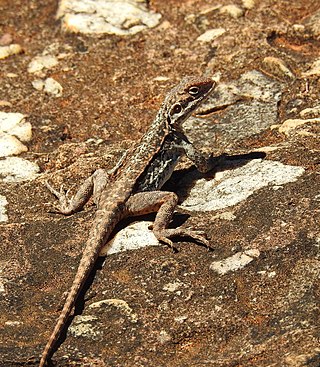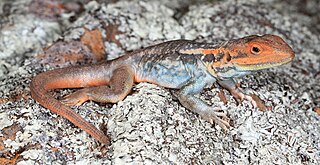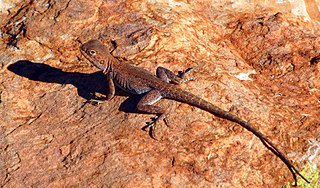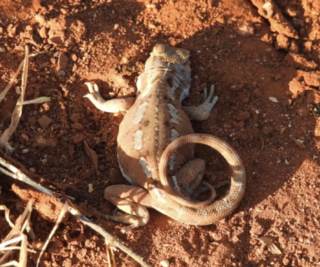
Agamidae is a family of over 300 species of iguanian lizards indigenous to Africa, Asia, Australia, and a few in Southern Europe. Many species are commonly called dragons or dragon lizards.

Ctenophorus is a genus of lizards, commonly known as comb-bearing dragons, in the family Agamidae. The genus contains the most diverse group of dragon lizards in Australia. It is the largest group of Australian lizards and it has an extensive radiation in the arid zones. Many of the species of Ctenophorus have been grouped by a similar morphology. The informal names and groupings within this genus — rock dragon, crevice-dragon, ground-dragon, sand-dragon, and bicycle-dragon — are named after the mythological creature, the dragon.

The central bearded dragon, also known as the inland bearded dragon, is a species of agamid lizard found in a wide range of arid to semiarid regions of eastern and central Australia.

The sandhill dunnart is a species of small carnivorous Australian marsupial of the family Dasyuridae. It is known from four scattered arid areas of Australia: near Lake Amadeus in Northern Territory, the central Eyre Peninsula in South Australia, the southwestern edge of the Great Victoria Desert in Western Australia, and at Yellabinna in South Australia.

Ctenophorus reticulatus, the western netted dragon or western netted ground-dragon, is a species of lizard in the family Agamidae. It is found in South Australia, Western Australia and southern Northern Territory.

Ctenophorus maculosus, commonly known as the Lake Eyre dragon or salt-lake ground-dragon, is a species of agamid lizard endemic to South Australia. C. maculosus mainly inhabits the edges of salt lakes in South Australia, from which its common names are derived. It survives in this harsh habitat through adaptive mechanisms to tolerate high temperatures and lack of free water. The female C. maculosus possesses unique male rejection techniques which are currently the focus of further research.

Ctenophorus pictus, commonly known as the painted ground-dragon or painted dragon, is a species of lizard from the family Agamidae. It is endemic to the drier areas of southern and central Australia.

The Barrier Range dragon is an agamid lizard which has been newly described (2013) as a separate species from the tawny dragon. This species is endemic to Australia, restricted to just three sites in western New South Wales (NSW).

Ctenophorus fionni, also known as the peninsula dragon, Arcoona rock dragon or peninsula crevice-dragon, is a species of agamid lizard occurring only in South Australia.

Ctenophorus decresii, also known commonly as the tawny dragon or the tawny crevice-dragon, is a species of lizard in the family Agamidae. The species is endemic to Australia. The average snout-to-vent length (SVL) of the species is 80.76 mm (3.180 in) with larger individuals being around 89 mm (3.5 in) and smaller individuals around 72 mm (2.8 in). The optimal time for mating in this species is two to three weeks after the females emerge from hibernation. Eggs are typically laid from September to October with most of them being laid earlier in the period. C. decresii is known for its variations in throat colors which change based on environmental conditions. Its primary food sources consist of both vegetation and invertebrates, and it prefers to live in rocky habitats.

The variable fat-tailed gecko or burrow-plug gecko is a diplodactylid gecko endemic to central and arid inland areas of Australia. Widespread across the continent, the variable fat-tailed is most commonly found in sandy desert habitats dominated by Spinifex grasses. They have also been bred in captivity by zoos and as pets.
The gibber earless dragon also known as the smooth-snouted earless dragon, is a species of agamid lizard endemic to Australia. It is one of a documented species of the genus Tympanocryptis, a group of small terrestrial lizards that feed off invertebrates and are characterised by the absence of an external ear structure.

The Mallee military dragon, also commonly known as the Mallee dragon or Mallee sand-dragon, is a species of agamid lizard occurring in the arid parts of southern Australia. The Mallee military dragon's specific name, fordi was named after Dr. Julian Ralph Ford (1932-1987). Dr. Ford was an ornithologist, herpetologist and chemist who worked at the Western Australian Museum. He collected the lizard holotype and many of the paratypes.

Ctenophorus isolepis, commonly known as the central military dragon, military dragon or military sand dragon, is a species of agamid lizard occurring in the arid parts of central and western Australia.

Ctenophorus caudicinctus, commonly known as the ring-tailed dragon or ring-tailed bicycle-dragon is a native species of agamid lizard occurring in rocky ranges and outcrops of Australia. Ctenophorus caudicinctus is most commonly found in the Pilbara region and offshore islands of Western Australia. The ctenophorus has 28 known species in the northern, southern, and western parts of Australia. It is recognized to be the most speciose group of Australian agamids.
Ctenophorus mckenziei, more commonly known as the dwarf-bicycle dragon, is a species of endemic Australian lizard within the family Agamidae and genus Ctenophorus. Originally identified as the agamid Amphibolurus mckenziei, the lizard had been identified within the regions of Western Australia and South Australia in which it occupied the shrubbery and woodland areas as its habitat. It was subsequently transferred to the genus Ctenophorus along with other Agamid species in which it shared similar morphology and characteristics. The name mckenziei is in reference to Norman Leslie Mckenzie, who was a zoologist and discovered the existence of the lizard. Listed on the IUCN red list page, threats to its population numbers are evaluated as least concern; however, their numbers are threatened by habitat loss, climate change, and feral predators.

Ctenophorus parviceps, commonly known as the Gnaraloo heath dragon or northwestern heath dragon is a species of agamid lizard occurring in pale coastal sands and shell grit with open heaths and beach spinifex, between the North West Cape and Carnarvon, Western Australia and on Bernier Island. The Gnaraloo Heath Dragon is a lizard that can be found along the coast of Western Australia between Exmouth Gulf and Shark Bay, and is also known as the Northwestern Heath Dragon. It is native to Australia and usually inhabits sandy coastal dunes. The species’ longevity is 3–50 years and its population density is extremely low. The Gnaraloo Heath Dragon is a member of the Agamidae family, which contains 15 genera. The lizard is under the Ctenophorus genus which has up to 33 species. This genus shows the most morphological and ecological diversity out of the three large agamid genera. 83% of the lizards in this genus lack a crest, while 17% possess crests. They are smaller than most agamids but do have relatively large heads. The Gnaraloo Heath Dragon can be differentiated from related species by a series of spines on the tail's base, a pale-grey brown broad vertebral band along its back, and hour-glass bars extending upwards to meet the pale vertebral band. It is usually 45mm in terms of length, measuring from snout to vent.

The desert egernia or unadorned desert-skink, desert skink, is a species of skink, a lizard in the family Scincidae. The desert egernia is endemic to the continent of Australia, and is widespread, with populations recorded in all mainland states and territories except the Australian Capital Territory. The desert egernia is found in dry, desert areas with deep, uncompacted sandy/loamy soils and little significant vegetation cover.

Leonhardi's ctenotus, Leonhardi's skink, or common desert ctenotus is a species of skink found in a range of arid and semi-arid regions throughout mainland Australia. The species was named after German anthropologist Moritz von Leonhardi in 1919 and belongs to the Ctenotus genus, one of the largest genera of lizards in Australia.

Diporiphora nobbi, also known commonly as the nobbi lashtail or the nobbi, is a species of lizard in the family Agamidae. The species is endemic to Australia.























